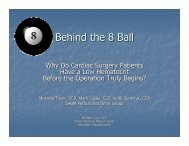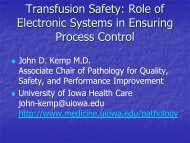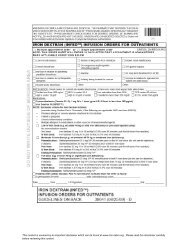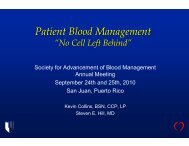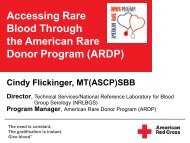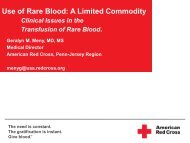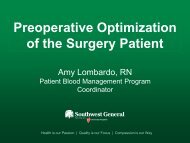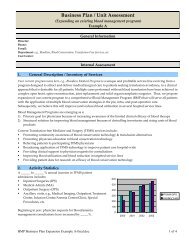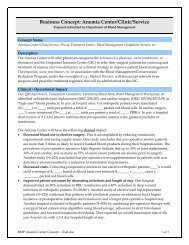Jehovah's Witness Patients Undergoing Major Urologic Surgery in ...
Jehovah's Witness Patients Undergoing Major Urologic Surgery in ...
Jehovah's Witness Patients Undergoing Major Urologic Surgery in ...
Create successful ePaper yourself
Turn your PDF publications into a flip-book with our unique Google optimized e-Paper software.
Jehovah’s <strong>Witness</strong> <strong>Patients</strong><strong>Undergo<strong>in</strong>g</strong> <strong>Major</strong> <strong>Urologic</strong> <strong>Surgery</strong> <strong>in</strong>the Robotic <strong>Surgery</strong> EraDaniel Eun, MDAssistant Professor of UrologyDirector of M<strong>in</strong>imally Invasive Robotic <strong>Urologic</strong> Oncology & ReconstructionPennsylvania HospitalUniversity of Pennsylvania
Welcome to the City ofBrotherly Love!
Pennsylvania Hospital: Nation’s 1st- 1751Penn Med: Nations’s 1st Med School- 1765
The adoption of robot-assistedradical prostatectomyCourtesy Intuitive Surgical
•
Robotic Prostatectomy:Position<strong>in</strong>g & Incisions
What else beyondprostatectomy?
• Urology residency &18 month robotics fellowship• 2001-2008: 4500 cases performed (peak: 800 cases/year)• 4-7 cases/day (local/regional/<strong>in</strong>terstate/<strong>in</strong>ternational patients)• 3 years spent on dedicated robotics tra<strong>in</strong><strong>in</strong>gTra<strong>in</strong><strong>in</strong>g at Henry Ford Hospital, Detroit:2002-2008• 2001: Prostate program• 2003: Nephrectomy and cystectomy program• Intro DV-S platform 2006-2007: Kidney protocol formalized @ Intuitive HQ• Cooperative with Mansoura, Egypt and Kuala Lumpur, Malaysia• Numerous travel opportunities for residents/fellows• Multi-specialty collaboration & procedure development• GYN• Bariatrics• Transplant: donor nephrectomy• Hepato-biliary: partial hepatectomy
“Danny, One day this will justbe urology”-Mani Menon 2005(Urology Chairman Henry ford Hospital)
“Danny, let’s be careful <strong>in</strong>advertis<strong>in</strong>g what we reallycan do”-Alan We<strong>in</strong> 2008(Urology Chairman university of Pennsylvania)
• UreterolysisCurrent Robotic Urology Program:• Ureterolithotomy• Cystolithotomy>30 robotics procedures offered• Pyelolithotomy• Pyeloplasty• Intracorporeal Ileal Loop Diversion• Radical cystoprostatectomy• Anterior/total pelvicexenteration• Partial cystectomy• Urachal resection• Bladder diverticulectomy• Simple prostatectomy• Radical prostatectomy• Extended template pelvic & periaortic LND
Regional Referral Center for HighRisk patientsJehovah’s <strong>Witness</strong> patients: > 30 patients <strong>in</strong> 3 yrs“Hostile abdomens” (Whipple, TAH/BSO, EC Fistula, Mesh)Previous radiation, brachytherapy, TURP/KTP laserMedically complex patients: cardiac stents/ASAMorbidly obese: up to BMI 71 (flank) & BMI 45 (pelvis)Iatrogenic <strong>in</strong>juries need<strong>in</strong>g reconstruction “High litigationpotential” (ie: Mid ureteral avulsion)Advanced/complex cancer cases: solitary kidney, horseshoe
Current Experience: Pennsylvania Hospital 2006-11Refer to posterGolan, Llukani, Eun: Comparison of robotic vs openurologic patients <strong>in</strong> Jehovah’s <strong>Witness</strong> patients: A s<strong>in</strong>glecenter experience
Challeng<strong>in</strong>g Cases
Case #1: Adrenal Lesion
QuickTime and adecompressorare needed to see this picture.
Case #2: Pa<strong>in</strong>less gross hematuria• 62 yo female w/pa<strong>in</strong>less GH w/clots• Referr<strong>in</strong>g urologist did a 88 gm TURBT• “I th<strong>in</strong>k there’s a lot more <strong>in</strong> there!”• Pathology: grade 2 SCC w/ deep muscularispropria <strong>in</strong>vasion
Case #2: Pa<strong>in</strong>less gross hematuria• MRI showed posterior 5 cm bladder masswithout hydronephrosis or lymphadenopathy.• Bone scan neg.
Case #2: Pa<strong>in</strong>less gross hematuria• 62 yo female with muscle <strong>in</strong>vasivesquamous cell carc<strong>in</strong>oma of the bladder• Options: Open vs Robotic AnteriorExenteration.• Plan: Opted for robotic ant exent withextended pelvic lymphadenectomy andileal loop ur<strong>in</strong>ary diversion
Bladder Cancer:Extended Template Pelvic LND
Bladder Cancer:Extended Template Pelvic LND
dder Cancer: Extended Template Pelvic LND
ILEAL LOOPUROSTOMY & BLURETERAL STENTSIncisions
UrachusOvariesFallopian TubesUterusBladderCervixAnterior Vag<strong>in</strong>aUrethra with Foley
Postop• Discharged: POD#6• F<strong>in</strong>al pathology:• 5.5 cm G1 SCC <strong>in</strong>vad<strong>in</strong>g through detrusor and<strong>in</strong>to peri-cervical tissues (T4a)• All marg<strong>in</strong>s negative• 56 lymph nodes: Neg• 18 months: NED on CT, Bone scan
Case #3:Renal mass on a solitarykidney
QuickTime and adecompressorare needed to see this picture.
Case #4• CC: Abdom<strong>in</strong>al pa<strong>in</strong>• 59 year old JW female• PMH: BMI 61, HTN, CHF, MI, Afib,Ischemic Cardiomyopathy, OSA,Pickwickian syndrome on Home O2• PSH: Gastric bypass, BL TKA,Pacemaker• Creat<strong>in</strong><strong>in</strong>e: 1.0
Case #4• CT A/P: Enhanc<strong>in</strong>g 6 cm solid renalupper pole mass c/w maligancy (90%endophytic)• CT Chest: Neg• Bone scan: Neg• Renal Bx: Clear cell RCC
Case #4• Assessment: Morbidly obese JW cardiopulmon-vasculopathfemale with 6 cm(cT1b) RCC• Plan:• 1) Open partial nephrectomy on iceslush Vs Lap radical nephrectomy VsRobotic partial nephrectomy• 3) Cardiac & pulmonary clearance• 4) Bloodless medic<strong>in</strong>e consult
Case #4• Bloodless medic<strong>in</strong>e: Preop Hgb 11• Ferric gluconate and darbepoet<strong>in</strong>• Preop cardiac cath: EF 30%, multipleocclusive coronaries• Undergoes 4 vessel CABG
Case #4• Return to office 1 year later• Creat<strong>in</strong><strong>in</strong>e up to 2.5, now 1.3• New CT C/A/P: Mass now 7.5 cm. Nolung lesions, LA or renal ve<strong>in</strong> <strong>in</strong>vasion• Bone scan: Neg• Renal scan: 60% right/40% left splitfunction
CT IMAGINGQuickTime and aAnimation decompressorare needed to see this picture.
QuickTime and aH.264 decompressorare needed to see this picture.
Perioperative course• Operative time 120m<strong>in</strong>utes• Warm ischemia 45m<strong>in</strong>utesExtraction <strong>in</strong>cision• EBL: 500 cc• Postop Hgb nadirto 6.7• D/c Home POD #7
Case #4: Pathology• 7.7 cm Grade 2 Clear Cell RCC• 4 Hilar Lymph Nodes Negative• Marg<strong>in</strong>s: Negative
Case #5• Cc: R testis mass• 27 yo healthy JW male• Scrotal U/S: 4 solid masses <strong>in</strong> right testis(largest 2.7 cm)• Markers elevated: Hcg 624, AFP 161• Social: Recently married, no kids
Case #5• Banked sperm• Right Ingu<strong>in</strong>al Orchiectomy: 2.5 cmchoriocarc<strong>in</strong>oma 50%/embryonal 50%;tumor conf<strong>in</strong>ed to testis; cord marg<strong>in</strong>negative• CT C/A/P: Neg• 4 week serum markers: Normal
Case #5• Assessment: 27 yo recently married JWmale with Stage 1 NSGCT (50%embryonal) and normalized markers• Options: Surveillance, Chemo, RPLND• Plan: After careful considerations, patientopted for nerve spar<strong>in</strong>g robotic rightmodified template RPLND
QuickTime and aH.264 decompressorare needed to see this picture.
Case #5Extraction<strong>in</strong>cision• Operative time 3 hours• EBL: 100 cc• D/C home POD #1
Case #5• Pathology pT1, N0, M0:• Cord marg<strong>in</strong> negative• 0/26 Para-caval & <strong>in</strong>teraortocavallymph nodesPre/Para-AorticInter-Aortocaval
Case #5• Successful antegrade ejaculation on POD #5• NED @ 18 months• Baby boy “that looks just like me!” born 3 weeksago
Robot not only enables execution of theseprocedures...But allows recovery from vascular <strong>in</strong>juries• Weck clip applicator• Robotic Weck clip applicator• E Tape: 4X18 Lap sponge: <strong>in</strong>troduced via 12 mm port• 4-0 Prolene on RB-1 needle- cut to 4”• Robotic needle driver X2• Vascular surgeon/vascular <strong>in</strong>strument tray on backtable
Vascular <strong>in</strong>jury protocol• Compression + Time= Control your environment• Compress or grasp bleed<strong>in</strong>g• Suction field• Recover pneumoperitoneum• Sequentially change arms to needle drivers• Make sure you have everyth<strong>in</strong>g you need• Deep breath, focus… repair• Let everyone go to bathroom
QuickTime and aH.264 decompressorare needed to see this picture.
“Auribus tenere lupum”(“I hold a wolf by the ears”)- TerenceInterpretation:I am <strong>in</strong> a dangerous situation and dare notlet go.
THANKYOU!!!daniel.eun@uphs.upenn.edu



